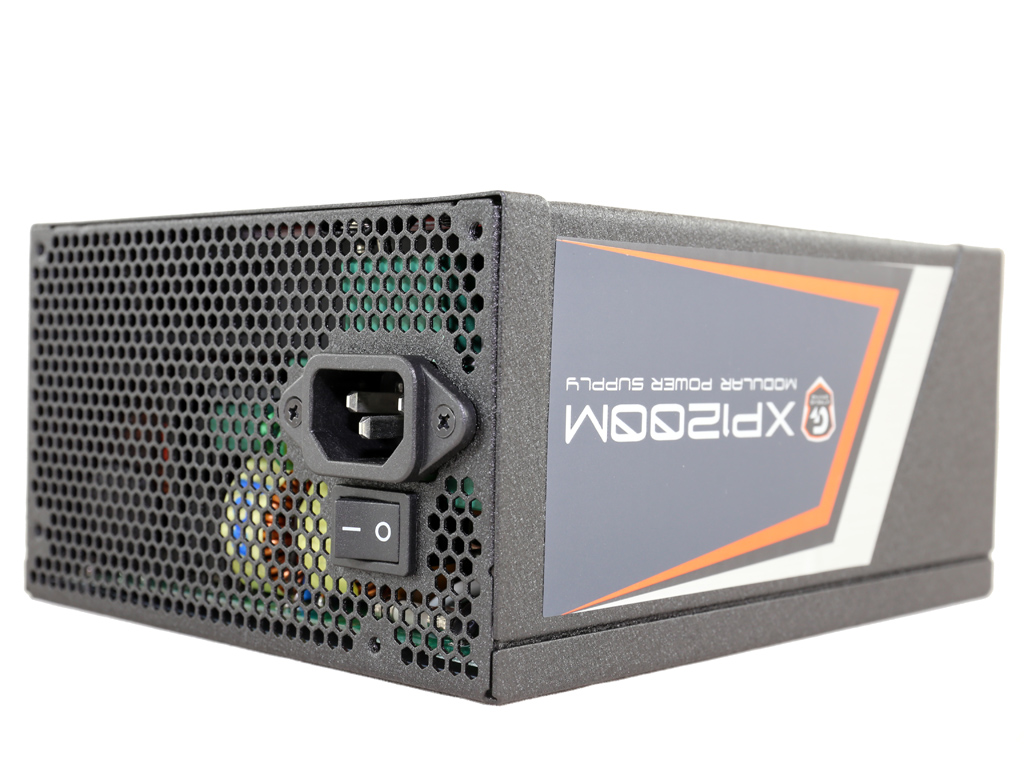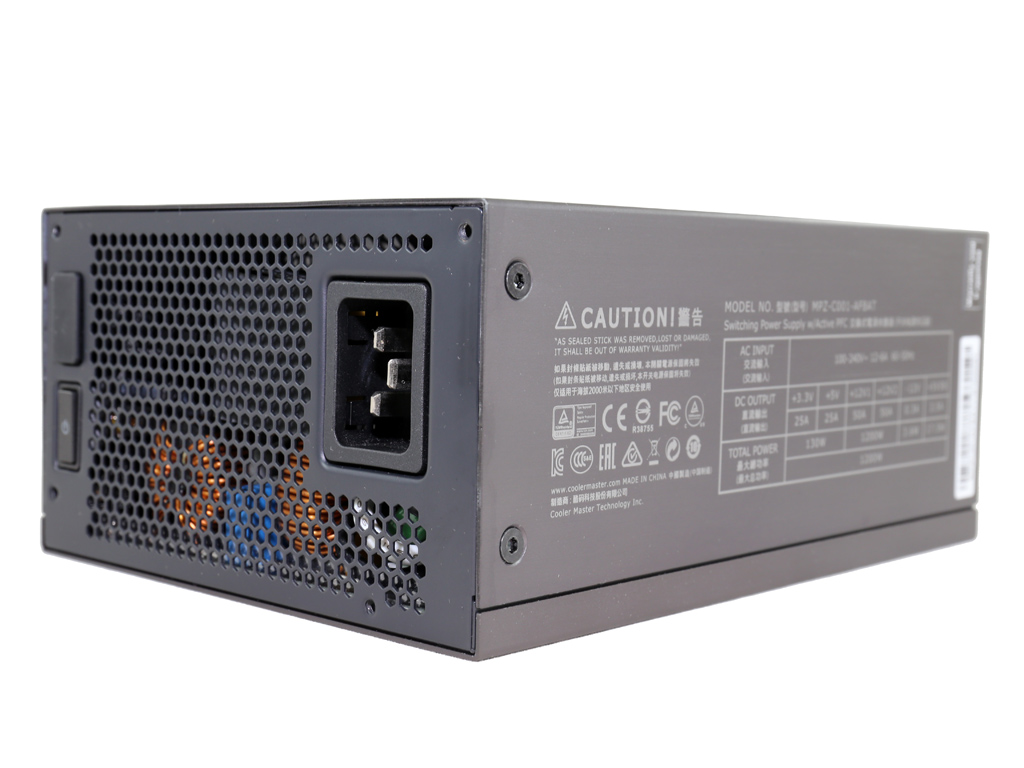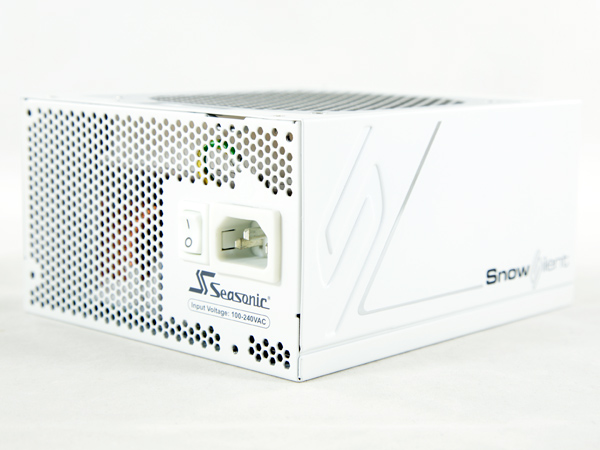Gigabyte Xtreme Gaming 1200 W PSU Review
Gigabytes re-enters the high-end PSU market with its Xtreme Gaming 1200 W PSU. Besides high capacity, it also features Platinum-rated efficiency, modular cables, and interesting looks. This unit is built to meet the demands of enthusiasts, to be sure.
Why you can trust Tom's Hardware
Load Regulation, Hold-Up Time, And Inrush Current
To learn more about our PSU tests and methodology, please check out How We Test Power Supply Units.
Primary Rails And 5VSB Load Regulation
Load Regulation testing is detailed here.
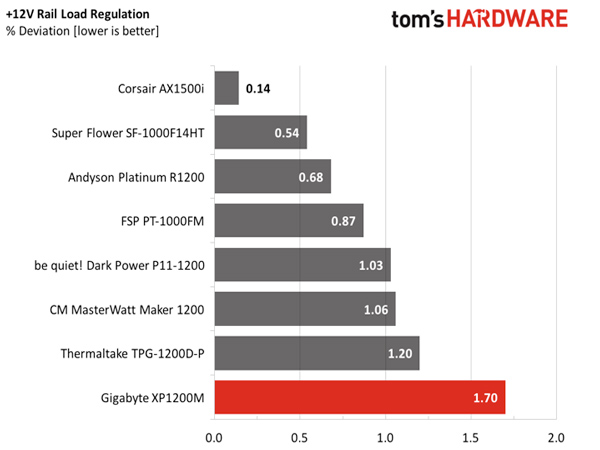
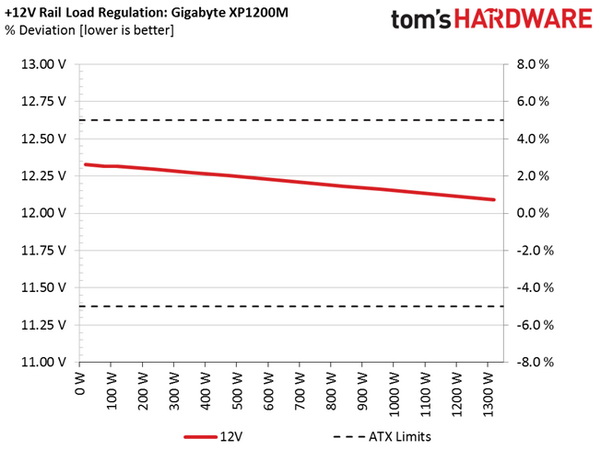
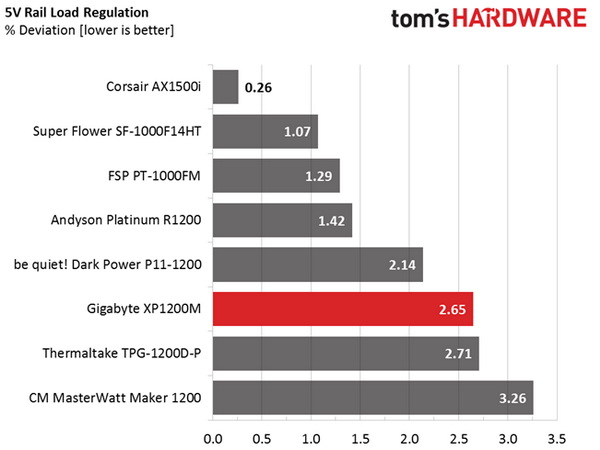
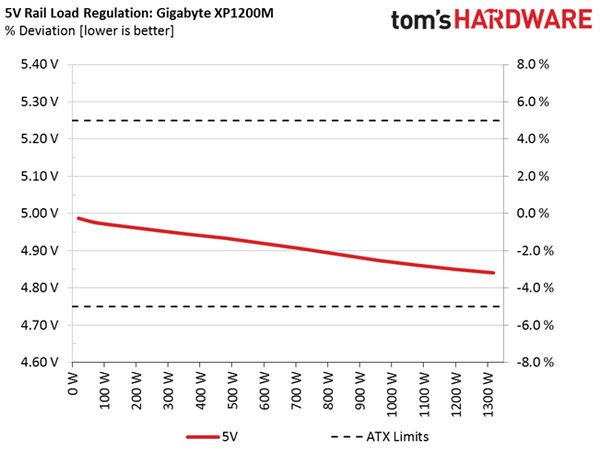
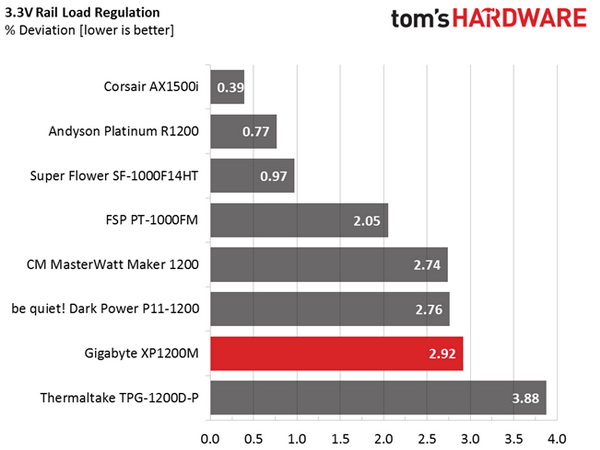
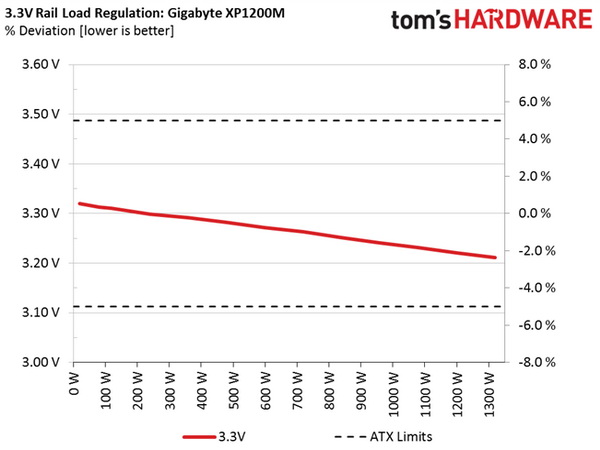
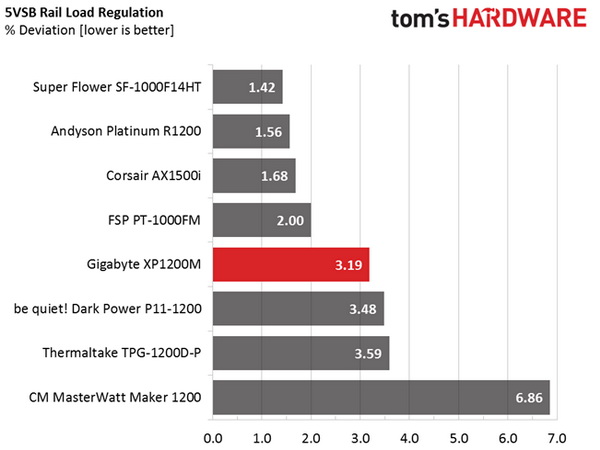
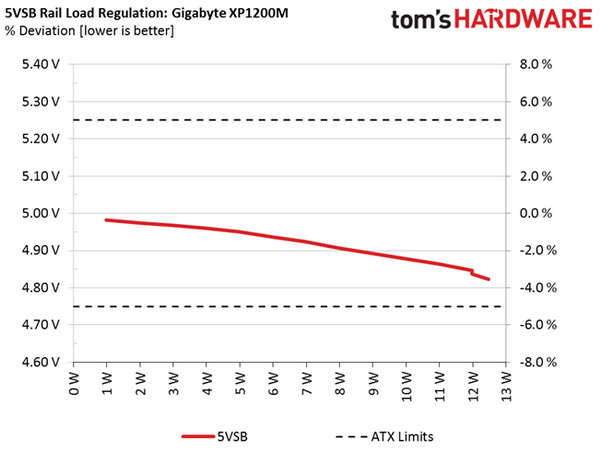
Hold-Up Time
Our hold-up time tests are described in detail here.
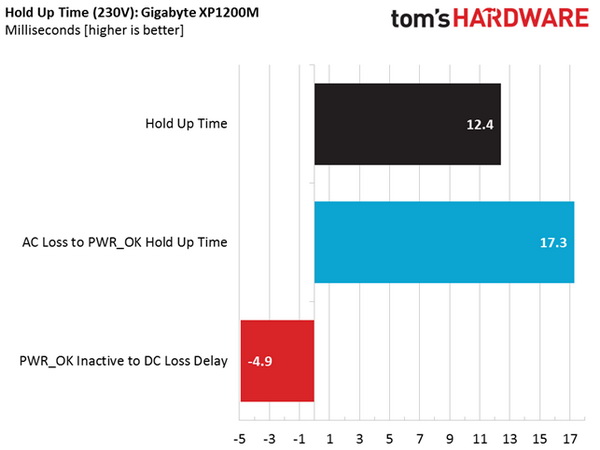
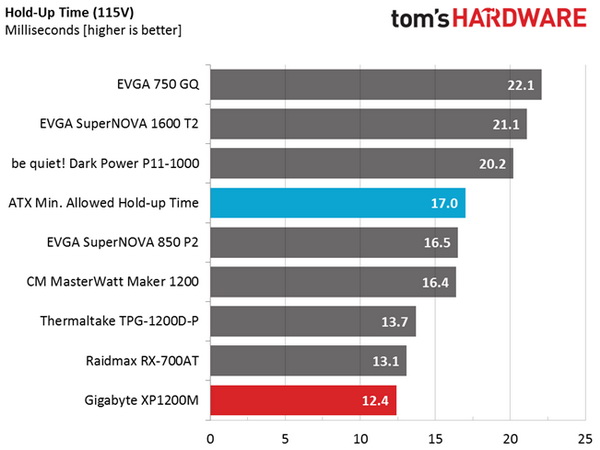
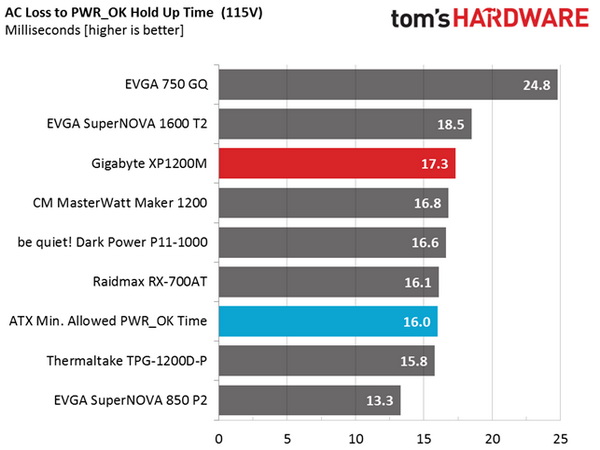
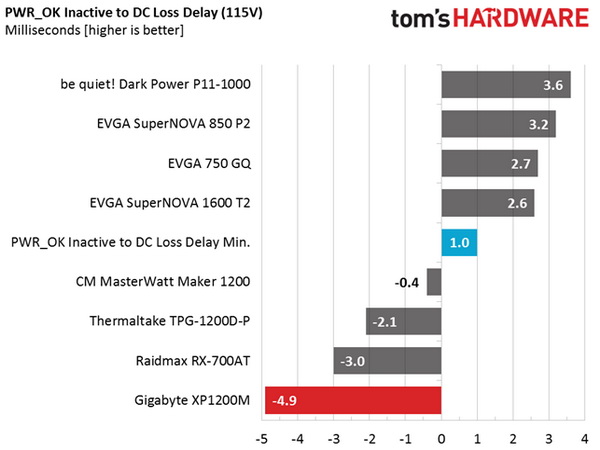
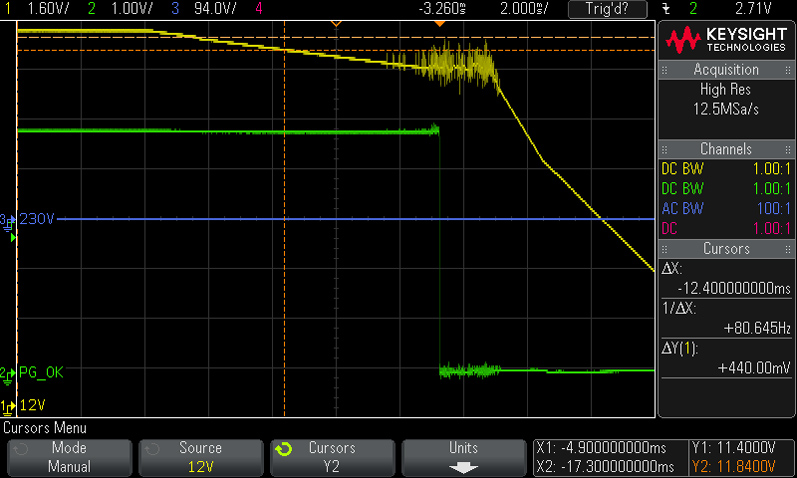
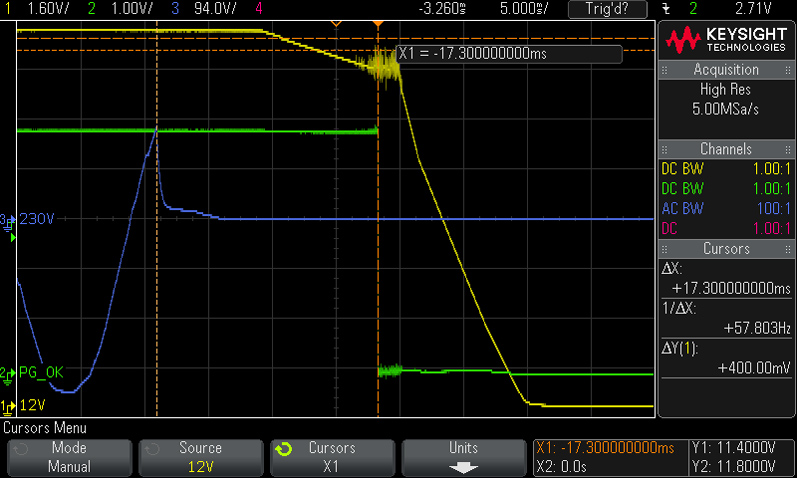
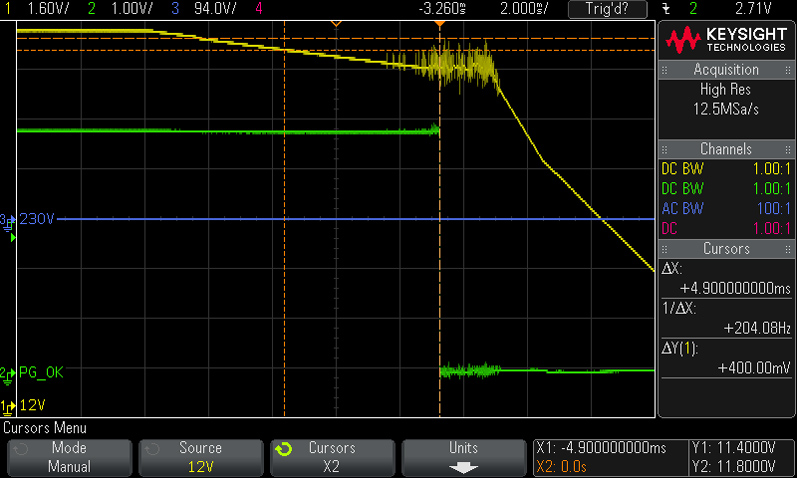
Not only is the measured hold-up time lower than 17 ms (the ATX specification's minimum allowed), but the power-good signal drops after the rails go out of spec. This is a great shame.
Inrush Current
For details on our inrush current testing, please click here.
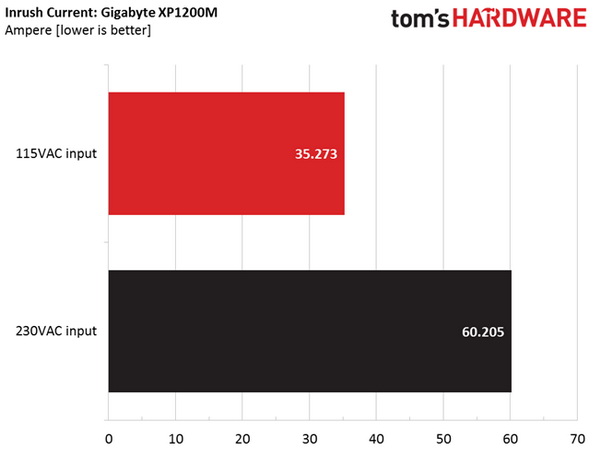
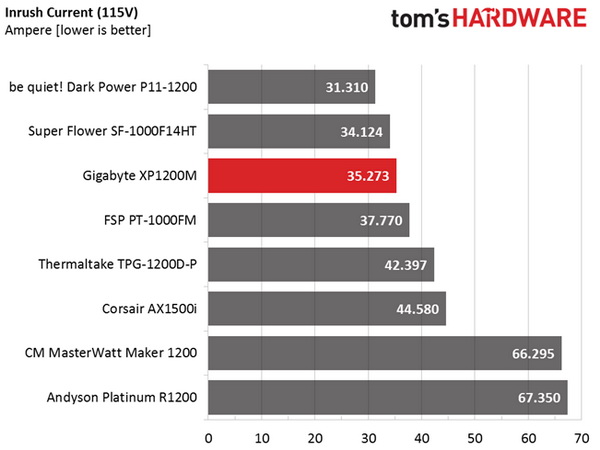
The inrush current is low with 115 V and normal with 230 V input.
Load Regulation And Efficiency Measurements
The first set of tests reveals the stability of the voltage rails and the PSU's efficiency. The applied load equals (approximately) 10 to 110 percent of the maximum load the supply can handle, in increments of 10 percentage points.
Get Tom's Hardware's best news and in-depth reviews, straight to your inbox.
We conducted two additional tests. During the first, we stressed the two minor rails (5V and 3.3V) with a high load, while the load at +12V was only 0.1 A. This test reveals whether a PSU is Haswell-ready or not. In the second test, we determined the maximum load the +12V rail could handle with minimal load on the minor rails.
| Test # | 12V | 5V | 3.3V | 5VSB | DC/AC (Watts) | Efficiency | Fan Speed | Fan Noise | Temps (In/Out) | PF/AC Volts |
|---|---|---|---|---|---|---|---|---|---|---|
| 1 | 7.968A | 2.016A | 1.991A | 1.007A | 119.74 | 84.90% | 1610 RPM | 49.7 dB(A) | 40.79 °C | 0.955 |
| 12.317V | 4.970V | 3.310V | 4.951V | 141.04 | 43.45 °C | 115.1V | ||||
| 2 | 16.976A | 3.022A | 2.999A | 1.212A | 239.56 | 90.33% | 1650 RPM | 49.8 dB(A) | 41.21 °C | 0.975 |
| 12.294V | 4.957V | 3.299V | 4.937V | 265.20 | 44.27 °C | 115.1V | ||||
| 3 | 26.370A | 3.530A | 3.521A | 1.419A | 359.67 | 91.36% | 1820 RPM | 50.1 dB(A) | 42.13 °C | 0.983 |
| 12.273V | 4.945V | 3.291V | 4.923V | 393.67 | 45.59 °C | 115.1V | ||||
| 4 | 35.781A | 4.057A | 4.018A | 1.629A | 479.55 | 91.49% | 1975 RPM | 53.2 dB(A) | 42.96 °C | 0.988 |
| 12.251V | 4.933V | 3.282V | 4.906V | 524.16 | 46.86 °C | 115.1V | ||||
| 5 | 44.892A | 5.080A | 5.040A | 1.838A | 599.46 | 91.24% | 2090 RPM | 54.0 dB(A) | 43.18 °C | 0.991 |
| 12.229V | 4.919V | 3.272V | 4.892V | 657.04 | 47.43 °C | 115.1V | ||||
| 6 | 54.040A | 6.120A | 6.066A | 2.045A | 719.40 | 90.27% | 2140 RPM | 54.4 dB(A) | 43.44 °C | 0.993 |
| 12.206V | 4.905V | 3.263V | 4.878V | 796.93 | 48.20 °C | 115.1V | ||||
| 7 | 63.220A | 7.155A | 7.100A | 2.260A | 839.21 | 89.74% | 2140 RPM | 54.4 dB(A) | 44.55 °C | 0.993 |
| 12.182V | 4.890V | 3.251V | 4.863V | 935.13 | 50.05 °C | 115.2V | ||||
| 8 | 72.433A | 8.205A | 8.145A | 2.473A | 959.16 | 89.13% | 2140 RPM | 54.4 dB(A) | 45.19 °C | 0.994 |
| 12.160V | 4.874V | 3.241V | 4.847V | 1076.09 | 51.49 °C | 115.1V | ||||
| 9 | 82.112A | 8.750A | 8.695A | 2.478A | 1079.21 | 88.35% | 2140 RPM | 54.4 dB(A) | 46.50 °C | 0.994 |
| 12.137V | 4.861V | 3.231V | 4.837V | 1221.49 | 53.85 °C | 115.1V | ||||
| 10 | 91.788A | 9.285A | 9.220A | 2.588A | 1199.03 | 87.50% | 2140 RPM | 54.4 dB(A) | 47.57 °C | 0.995 |
| 12.113V | 4.850V | 3.220V | 4.823V | 1370.30 | 56.13 °C | 115.2V | ||||
| 11 | 101.886A | 9.303A | 9.248A | 2.595A | 1319.01 | 86.60% | 2140 RPM | 54.4 dB(A) | 49.07 °C | 0.995 |
| 12.090V | 4.840V | 3.211V | 4.813V | 1523.11 | 59.35 °C | 115.2V | ||||
| CL1 | 0.097A | 14.024A | 14.005A | 0.000A | 116.21 | 79.56% | 2140 RPM | 54.4 dB(A) | 45.30 °C | 0.953 |
| 12.319V | 4.909V | 3.297V | 4.975V | 146.07 | 49.10 °C | 115.2V | ||||
| CL2 | 99.923A | 1.003A | 1.003A | 1.001A | 1223.20 | 87.68% | 2140 RPM | 54.4 dB(A) | 47.99 °C | 0.995 |
| 12.111V | 4.892V | 3.234V | 4.873V | 1395.02 | 56.87 °C | 115.2V |
Load regulation is decent, but it doesn't compete with the other high-end PSUs in this demanding category. We would like to see results closer to 1% on the +12V rail.
When it comes to efficiency, the XP1200M satisfies the 80 PLUS Platinum certification's requirements at 20% load, but it fails the 50% and full load tests. We do test at higher ambient temperatures than the 80 PLUS organization, which definitely affects efficiency. However, we expected higher efficiency from a $280 Platinum-rated unit that has to compete with the similarly-priced Corsair, EVGA, and Seasonic offerings.
Again, the fan profile goes crazy at over 40 °C ambient, resulting in a lot of noise. You'll need earplugs if you plan on operating this PSU under the stresses we apply.
Current page: Load Regulation, Hold-Up Time, And Inrush Current
Prev Page A Look Inside And Component Analysis Next Page Efficiency, Temperature & Noise
Aris Mpitziopoulos is a contributing editor at Tom's Hardware, covering PSUs.
-
turkey3_scratch Yawn. It's loud. Might not be too loud in most people's cases where the unit is sucking cool air from underneath the computer, and where they overestimate their power requirements, but it's still way too loud. If they're going to make the fan that aggressive, they should give it a longer warranty. Give it an ol' 11 year warranty to beat the competition at least.Reply
The only way Gigabyte is going to sell this at whatever price is if they do some marketing. "Nvidia Gigabyte GPUs work best with Gigabyte PSU" and people will buy it. -
powernod Enhance continoues its mediocre performance!!Reply
The only series i can remember, in which Enhance showed some very good results were the Thermaltake's GRAND Platinum line.
Besides that,..... just mediocre !! -
Vorador2 When i saw that it used the word "xtreme" (ugh) and "gaming" together in the name of the product i knew it was going to be either overpriced or underperforming. Or both.Reply -
Sam Hain In the 1.2kw range... The EVGA SuperNOVA 1200 P2 is a great buy @$230 (or so), awesome specs and performance across-the-board and some of the highest customer ratings to back it's build quality.Reply
